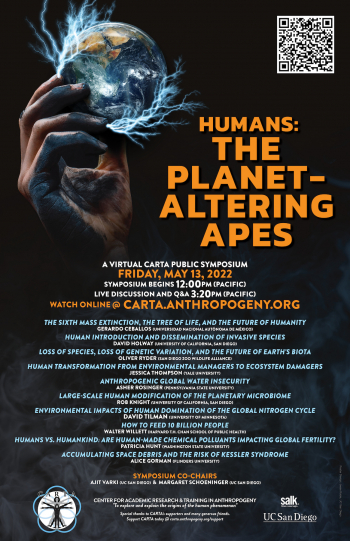Humans: The Planet-Altering Apes
Ajit Varki, UC San Diego School of Medicine
Margaret Schoeninger, UC San Diego
Summary:
CARTA is a broad-based coalition of scholars interested in defining and explaining the evolutionary origins of humans and in generating testable hypotheses and new agendas for research on this subject. CARTA public symposia emphasize our primary objectives –– to explore and explain where we humans came from, and how we got here. Given the focus on human origins, we generally limit discussions of current day implications and questions regarding the future of humanity.
However, we now feel the urgent moral and practical imperative to call attention to the long- and short-term impact of humans on the planet that we inhabit, and the consequences for the future of our species. Accordingly, on March 5, 2022, CARTA presented "Human Origins and Humanity's Future: Past, Present and Future of the Anthropocene,” co-chaired by Leslie Aiello (University College London) and Charles Kennel (Scripps Institution of Oceanography and University of Cambridge), which introduced discussion on the current age of human activity, coined the “Anthropocene.”
To elaborate upon and extend this discussion, this symposium will address specific examples of how humans have drastically altered the planet. Acknowledged experts will discuss clearly defined global-scale negative impacts on planet earth, our life support system (other than climate change, population growth and infectious diseases, which are well-known). Each talk will succinctly describe a specific impact, the role that our species has played, and conclude with ongoing or potential approaches to mitigation.
In the process, we are coming full circle to Anthropogeny, asking how a single species could have evolved the ability to so drastically alter the entire planet.
Funding for this symposium was provided by many generous CARTA donors, with additional support from CARTA Patrons Elizabeth Lancaster & Eli Shefter (in honor of The Bees); CARTA Friends Feroza Ardeshir & Suresh Subramani (in honor of Dr. Nissi M. Varki), Kathlyn Furr, and Pamela N. & Michael Swartout; as well as CARTA Supporters Kalvin Drake, Guy Miller, Christoph Roehrig, and John Sterling. Closed captioning for the recordings was made possible by CARTA Patrons Ingrid Benirschke-Perkins & Gordon Perkins.
Media for each talk can be played by clicking on icons in the table below, or by clicking on the individual talk titles below and then the attachment file at the bottom of the page.
| Speakers | Media | Session |
|---|---|---|
 Ajit Varki |
|
Welcome & Opening Remarks |
 Gerardo Ceballos |
|
The Sixth Mass Extinction, the Tree of Life, and the Future of Humanity Vitus Bering, the famous explorer, led perhaps the most ambitious scientific expedition ever in the 1730s. Commanding 10,000 people, he was in charge of exploring the vast lands of Siberia and the unknown sea between Siberia and Alaska. In 1741, he was forced to land on what would be later known as Bering Island, where he would die. In his crew was a doctor and naturalist, Georg Steller, who discovered in the calm waters close to the island a massive three-ton marine mammal, similar to a... read more |
 David Holway |
|
Human Introduction and Dissemination of Invasive Species The introduction of species into new environments has occurred throughout human history. Over the last century, however, the rate of new introductions has exponentially increased as a function of human population growth and the globalization of trade. While most introductions fail and most of those few that establish remain environmentally innocuous, a notable minority wildly proliferates in their new ranges. These invaders disrupt ecosystems and burden economies. Environmental impacts... read more |
 Oliver Ryder |
|
Loss of Species, Loss of Genetic Variation, and the Future of Earth’s Biota We are experiencing an accelerated rate of loss of species due to human activities. This anthropogenic phenomenon extends beyond extinction. It encompasses an expanded loss of biodiversity as the genetic diversity of species diminish, reducing gene pools to “gene puddles.” One-third of all species analyzed by the International Union for the Conservation of Nature (IUCN), are estimated to be undergoing population declines. Twenty-eight percent of 134,425 species assessed by IUCN are categorized... read more |
 Jessica Thompson |
|
Human Transformation From Environmental Managers to Ecosystem Damagers Beginning with Homo erectus at least a million years ago, hominins have used fire to engineer the world around them. The earliest uses of fire surely included cooking, changing the energy yields of foods. Such innovations altered the course of our evolution, facilitating the evolution of species that could adapt quickly using tools and social ingenuity. After 200,000 years ago, hominins also used fire to change the material properties of stone, pigments, sap, and wood. By at least 130,000 years... read more |
 Asher Rosinger |
|
Anthropogenic Global Water Insecurity Humans have adapted to meet their water needs across disparate environments over time using behavioral adaptations. Yet, as temperatures rise and freshwater sources become depleted, it is critical to understand 1) how populations modify their environments to meet their water needs, and 2) the consequences of these anthropogenic - or human caused changes - on the environment and further on human health. This talk will provide an overview of different global water challenges and focus on a couple... read more |
 Rob Knight |
|
Large-scale Human Modification of the Planetary Microbiome Through the Earth Microbiome Program and complementary efforts, we have sampled a broad range of microbiomes from across the planet. All microbiomes that have been studied are impacted by human activity — the effects of industrialization on the human microbiome are best characterized, but capture of animals in zoos, domestication, modification of soils through agricultural practices, and modification of freshwater and marine microbiomes have all been well characterized. Indeed, the pervasive... read more |
 David Tilman |
|
Environmental Impacts of Human Domination of the Global Nitrogen Cycle Humans now annually add more biologically available nitrogen to the Earth’s land surfaces than do all natural processes. For 3 billion years, available nitrogen had been the major limiting currency for life on Earth. The recent human disruption of the global nitrogen cycle is causing major environmental harm, including water and air pollution, marine dead zones, 10% of global greenhouse gas emissions, and species extinctions. Three major ways to solve this nitrogen problem are (1) much more... read more |
 Walter Willett |
|
How to Feed 10 Billion People The world is facing a health crisis due to increasing rates of obesity and diabetes, and the consequences of this pandemic will accumulate over the coming decades. Simultaneously, climate change is accelerating and is already having devastating effects that will undermine our ability to feed the world’s growing population. In turn, our food systems contribute importantly to greenhouse gas emissions, water and land use, and multiple forms of pollution. Thus, a solution to feeding what will be... read more |
 Patricia Hunt |
|
Humans vs. Humankind: Are Human-made Chemical Pollutants Impacting Global Fertility? Human-made chemicals with the unexpected ability to interfere with our body’s endocrine system have become prominent contaminants in daily life. Because the hormones produced by our endocrine system create complex signaling networks that control our growth, maturation, fertility, immunity, behavior, and sleep, these endocrine disrupting chemicals, or EDCs, can exert powerful biological effects. Declines in human fertility evidenced by falling sperm counts and increases in the incidence of... read more |
 Alice Gorman |
|
Accumulating Space Debris and the Risk of Kessler Syndrome In 1957, the USSR launched Sputnik 1, the first human object to leave Earth. In the 65 years since then the region of Earth orbit has become filled with satellites and space junk. The proliferation of debris has led to the prediction of Kessler Syndrome, a state where a never-ending cascade of collisions between orbital objects renders parts of space unusable for human purposes. However, there are many different ways to look at the space junk surrounding Earth. For example, it is also an... read more |
 All Speakers  Margaret Schoeninger |
|
Question & Answer Session and Closing Remarks |
| Attachment | Size |
|---|---|
| 534.19 KB | |
| 164.65 KB | |
| 1.54 MB |
If you enjoy this event, please consider supporting CARTA's quest to explore and explain the human phenomenon.


